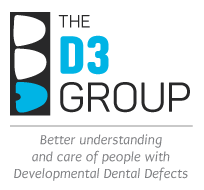D3 RESEARCH STANDARDS & GUIDELINES
Cross-sector recognition of the urgent need for standardisation – particularly across communication (terminology & language), research (classification & definition of Molar Hypomin) and clinical practice (research-friendly clinical standards & guidelines) – was the "numero uno" outcome of our 2020 D3 Workshop.
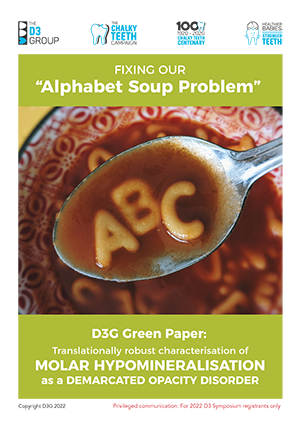
In preparation for the follow-on 2021 D3 Research Incubator,
a green paper ("Draft Consensus D3 Research Standards & Guidelines") was prepared in consultation with the "D3 brain trust" then shared with webinar participants as "homework" before the event. This "mark 1" draft – which focussed on classification, audience-specific definitions, terminology, grading & recording of MH – received broad support from across the sector (including professional organisations, industry and leading publishers). Consequently, after some refinement to reflect Incubator discussion, the "mark 2" version (now titled "Fixing our Alphabet Soup Problem. D3G Green Paper on translationally robust characterisation of Molar Hypomineralisation and other demarcated opacity disorders") was subjected to a further two consensus-seeking steps in 2022 – firstly at a Pre-symposium Task Force meeting on Clinico-scientific Standards (14 experts from 8 countries), then subsequently at the 2022 D3 Symposium in Toronto where a broader translational perspective was available (100+ participants from 22 countries). We plan to circulate the post-Symposium "mark 3" version across other key stakeholder groups shortly.
Meanwhile, the mark 2 green paper is available as part of the 2021 Incubator and/or 2022 Symposium video/CE packs (here), and the underpinning perspective article ("100 years of chalky teeth research") can be downloaded here. Additional examples of standardisation across academic and media contexts are available here, and see below for the Frontiers Article Collection.
Learn more about the Alphabet Soup Problem and our scientifically stronger approach to MH terminology here.
Enquiries are welcomed (contact us).
FRONTIERS RESEARCH TOPIC (ARTICLE COLLECTION)
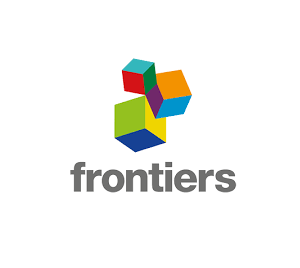
To broadcast academic outcomes from our Toronto D3 Symposia (2020 Workshop, 2021 Research Incubator, 2022 Toronto Symposium) and beyond, D3G has partnered with Frontiers – an innovative and translation-savvy publisher with broad reach across basic and health sciences – to develop an Article Collection (aka Research Topic) entitled "Molar Hypomineralisation and Chalky Teeth: From developmental physiology to social good". Remarkably, this new field-shaping initiative involves 4 leading journals (Frontiers in: Physiology; Dental Medicine; Public Health; Paediatrics), and so enabling exposure across an exceptionally broad audience in best translational fashion – learn more here, and download the Writer's Guidelines here. Note other relevant articles may be included when they support our translational mission and these guidelines.
PRIMER ON TRANSLATIONAL LANGUAGE (from 2020 D3 WORKSHOP)
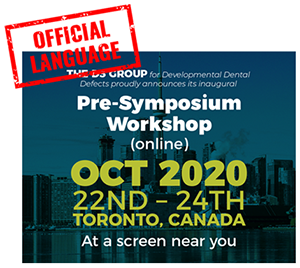
One groundbreaking element of our 2020 D3 Workshop was the first mass try-out for D3G's "chalky teeth lingo" across a broad range of stakeholders around the (English-speaking) world. This translational communication device was introduced to participants in the "D3 Discussion Framework document" used to shape the Workshop more generally (available as part of the video/CE pack here). Some excerpts from that document and the Workshop introduction follow. Note this is an ongoing "translational experiment" with an exceptionally broad audience in mind (from science-hungry kids through to rocket scientists and politicians) – feedback is welcomed! (contact us)
What do we mean by "chalky teeth", "D3s" and "decay"?
- "Chalky teeth" have (visibly) abnormal enamel due to developmental defects or early decay (see here)
- "D3s" stands for Developmental Dental Defects, the commonest of which affect enamel (see here)
- "Decay" embraces not only dental caries (acid attack from dental plaque), but also acid erosion (e.g. from acidic food and drink) and enamel breakdown (i.e. mechanical weakness or crumbliness) – all 3 aspects contribute to the health risks of chalky teeth (see here)
What do we mean by "chalky molars" & "molar hypomineralisation"?
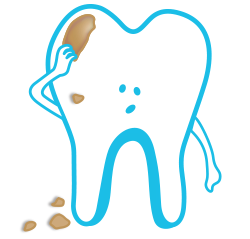
- These are back teeth (molars) with discoloured patches of defective enamel called "demarcated opacities" (see here)
- The 2-year (2nd baby/primary/deciduous), 6-year & 12-year (1st & 2nd adult/permanent) molars are affected most commonly (see here)
- The cause of demarcated opacities in molars is usually unknown ("idiopathic")
- We do use one term ("Molar Hypomin" or MH) to cover all molars and any other teeth with idiopathic demarcated opacities
- We don't use separate terms for 2-year molars ("HSPM") and 6-year molars ("MIH") for various scientific, clinical & translational reasons (see here and below)
What is "science translation" & "translational terminology"?
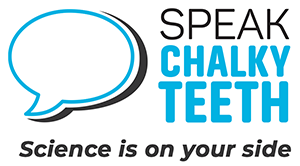
- "Science translation" is the 2-way process of (1) informing researchers about important problems needing their attention (e.g. population health, clinical issues, pathology & causation), then (2) converting consequent scientific progress into social good (e.g. better clinical practice, policy, products & prevention)
- "Translational terminology" enables meaningful 2-way conversations between specialists and the public, either starting with lay terms (e.g. "chalky teeth") and ending with specialised words useful to researchers (e.g. "idiopathic demarcated opacities"), or vice versa
- D3G has developed such a "translational lingo" for Molar
Hypomin, as explained for the public here, and as used by the diverse range of participants at our Toronto International D3 Symposia (here) and in D3G publications & media (here).
Distinguishing kids with Molar Hypomin from teeth with hypomineralisation

- It's important to realise that Molar Hypomineralisation (MH) is a case descriptor (referring to a person with hypomineralised teeth) – and not a tooth descriptor. When you think about the latter, "MH molars" (or "MH teeth") doesn't make sense because MH cases typically have one or more molars that are unaffected (normal). The same goes for "MH enamel", realising hypomineralised molars usually have some areas of normal enamel.
- The above issue is easily avoided by using "hypomineralised" (or "hypomin") when talking at tooth level. The abbreviation HM has long been used as counterpart to HP (standing for hypoplasia, a distinct type of enamel D3 – see here, here, here and here).
- When it comes to specifying individual teeth, the HM abbreviation can be linked with the Palmer and FDI/WHO/ISO notations for baby and adult teeth, respectively (pictured above). Hence, hypomin 2-year molars become HM-Es, and 6-year molars are denoted as HM-6s. It follows that a case involving 2-year and 6-year molars is denoted HM-Es+6s. This approach avoids the scientifically unsound situation associated with MIH and HSPM terminology – that is, there's no evidence to back the implication that MIH and HSPM are separate conditions (in contrast to a spectrum disorder, as connoted by the term MH). Learn more here.
